Case Study Analysis: COPD Exacerbation Management at Home - UWS
VerifiedAdded on 2023/06/11
|9
|2131
|269
Case Study
AI Summary
This case study analyzes a qualitative study focusing on patients' experiences in identifying and managing Chronic Obstructive Pulmonary Disease (COPD) exacerbations at home. The original study used a grounded theory approach, conducting interviews with 44 patients with moderate-to-very-severe COPD to explore their understanding and self-management strategies. The analysis reveals that patients identify exacerbations based on both measurable symptoms like cough and sputum, and less visible symptoms such as chest sensations. Many patients use a combination of self-management strategies, including self-medication and monitoring their recovery. The findings suggest that patients can effectively manage exacerbations, potentially reducing hospital admissions, and that these insights can be used to develop future interventions and empower patients in their self-care. This analysis highlights the importance of understanding patient perspectives in COPD management and using qualitative research to inform clinical practice.

Running head: ARTICLE ANALYSIS
Article Analysis
Student’s Name
University
Article Analysis
Student’s Name
University
Paraphrase This Document
Need a fresh take? Get an instant paraphrase of this document with our AI Paraphraser
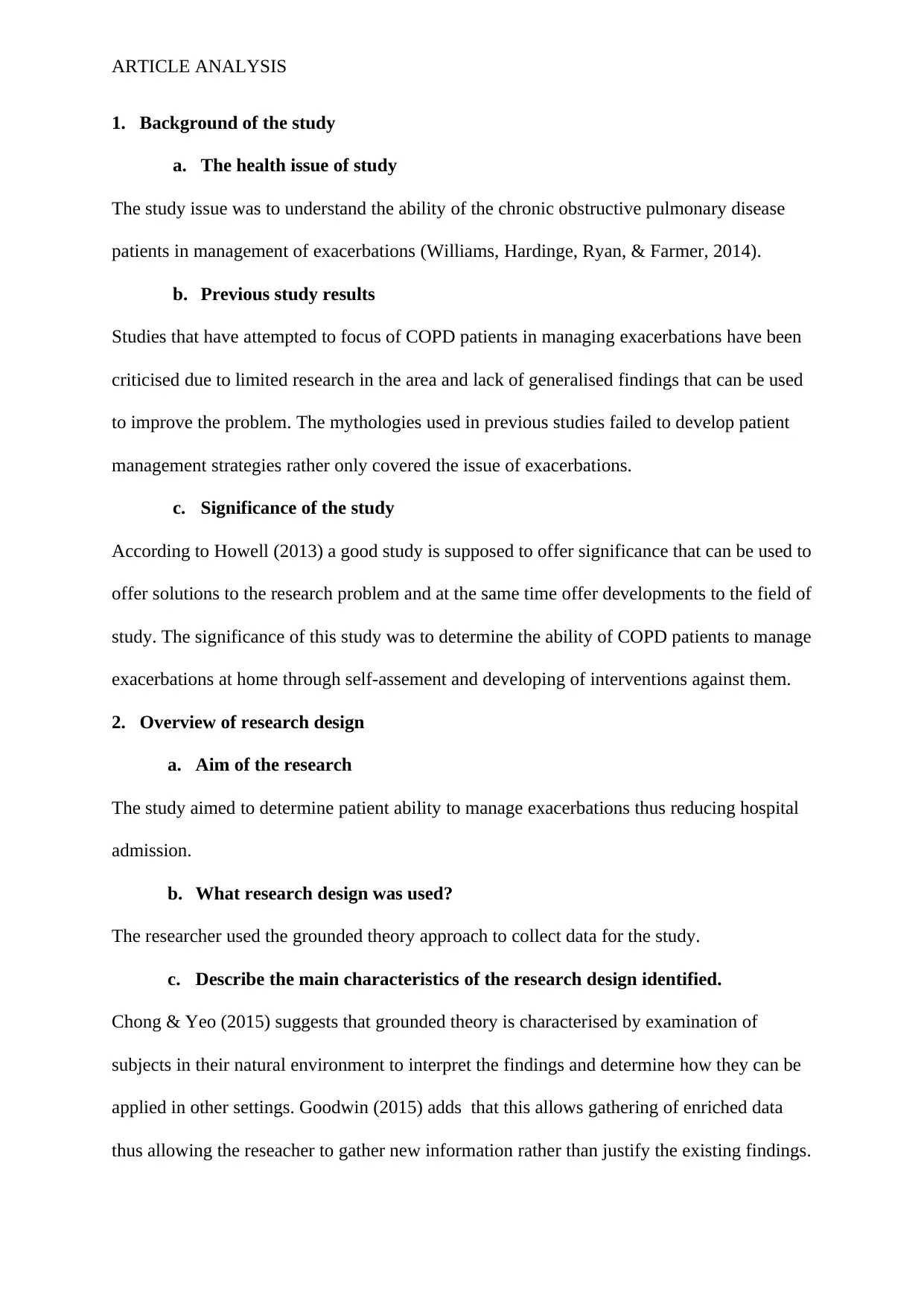
ARTICLE ANALYSIS
1. Background of the study
a. The health issue of study
The study issue was to understand the ability of the chronic obstructive pulmonary disease
patients in management of exacerbations (Williams, Hardinge, Ryan, & Farmer, 2014).
b. Previous study results
Studies that have attempted to focus of COPD patients in managing exacerbations have been
criticised due to limited research in the area and lack of generalised findings that can be used
to improve the problem. The mythologies used in previous studies failed to develop patient
management strategies rather only covered the issue of exacerbations.
c. Significance of the study
According to Howell (2013) a good study is supposed to offer significance that can be used to
offer solutions to the research problem and at the same time offer developments to the field of
study. The significance of this study was to determine the ability of COPD patients to manage
exacerbations at home through self-assement and developing of interventions against them.
2. Overview of research design
a. Aim of the research
The study aimed to determine patient ability to manage exacerbations thus reducing hospital
admission.
b. What research design was used?
The researcher used the grounded theory approach to collect data for the study.
c. Describe the main characteristics of the research design identified.
Chong & Yeo (2015) suggests that grounded theory is characterised by examination of
subjects in their natural environment to interpret the findings and determine how they can be
applied in other settings. Goodwin (2015) adds that this allows gathering of enriched data
thus allowing the reseacher to gather new information rather than justify the existing findings.
1. Background of the study
a. The health issue of study
The study issue was to understand the ability of the chronic obstructive pulmonary disease
patients in management of exacerbations (Williams, Hardinge, Ryan, & Farmer, 2014).
b. Previous study results
Studies that have attempted to focus of COPD patients in managing exacerbations have been
criticised due to limited research in the area and lack of generalised findings that can be used
to improve the problem. The mythologies used in previous studies failed to develop patient
management strategies rather only covered the issue of exacerbations.
c. Significance of the study
According to Howell (2013) a good study is supposed to offer significance that can be used to
offer solutions to the research problem and at the same time offer developments to the field of
study. The significance of this study was to determine the ability of COPD patients to manage
exacerbations at home through self-assement and developing of interventions against them.
2. Overview of research design
a. Aim of the research
The study aimed to determine patient ability to manage exacerbations thus reducing hospital
admission.
b. What research design was used?
The researcher used the grounded theory approach to collect data for the study.
c. Describe the main characteristics of the research design identified.
Chong & Yeo (2015) suggests that grounded theory is characterised by examination of
subjects in their natural environment to interpret the findings and determine how they can be
applied in other settings. Goodwin (2015) adds that this allows gathering of enriched data
thus allowing the reseacher to gather new information rather than justify the existing findings.
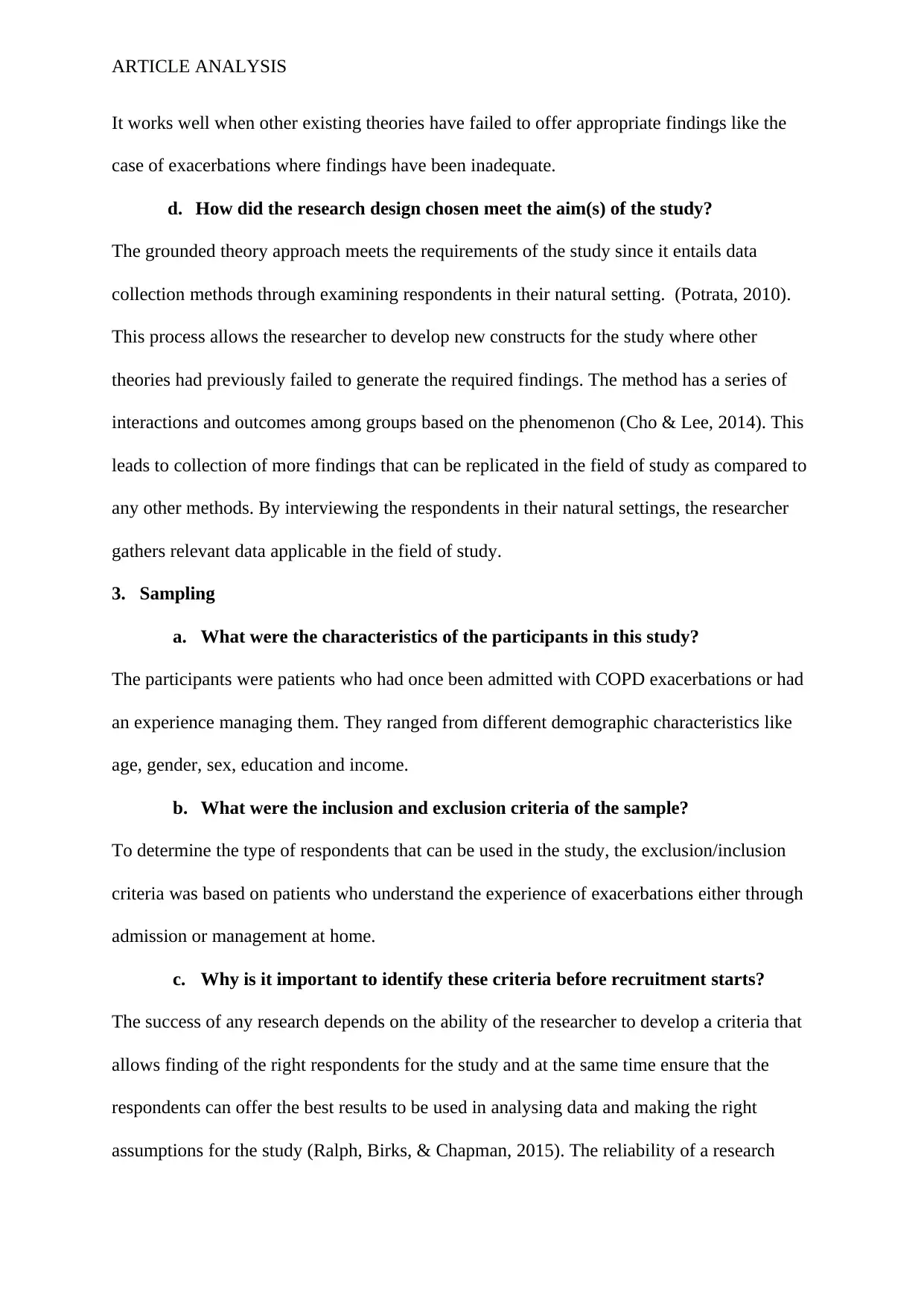
ARTICLE ANALYSIS
It works well when other existing theories have failed to offer appropriate findings like the
case of exacerbations where findings have been inadequate.
d. How did the research design chosen meet the aim(s) of the study?
The grounded theory approach meets the requirements of the study since it entails data
collection methods through examining respondents in their natural setting. (Potrata, 2010).
This process allows the researcher to develop new constructs for the study where other
theories had previously failed to generate the required findings. The method has a series of
interactions and outcomes among groups based on the phenomenon (Cho & Lee, 2014). This
leads to collection of more findings that can be replicated in the field of study as compared to
any other methods. By interviewing the respondents in their natural settings, the researcher
gathers relevant data applicable in the field of study.
3. Sampling
a. What were the characteristics of the participants in this study?
The participants were patients who had once been admitted with COPD exacerbations or had
an experience managing them. They ranged from different demographic characteristics like
age, gender, sex, education and income.
b. What were the inclusion and exclusion criteria of the sample?
To determine the type of respondents that can be used in the study, the exclusion/inclusion
criteria was based on patients who understand the experience of exacerbations either through
admission or management at home.
c. Why is it important to identify these criteria before recruitment starts?
The success of any research depends on the ability of the researcher to develop a criteria that
allows finding of the right respondents for the study and at the same time ensure that the
respondents can offer the best results to be used in analysing data and making the right
assumptions for the study (Ralph, Birks, & Chapman, 2015). The reliability of a research
It works well when other existing theories have failed to offer appropriate findings like the
case of exacerbations where findings have been inadequate.
d. How did the research design chosen meet the aim(s) of the study?
The grounded theory approach meets the requirements of the study since it entails data
collection methods through examining respondents in their natural setting. (Potrata, 2010).
This process allows the researcher to develop new constructs for the study where other
theories had previously failed to generate the required findings. The method has a series of
interactions and outcomes among groups based on the phenomenon (Cho & Lee, 2014). This
leads to collection of more findings that can be replicated in the field of study as compared to
any other methods. By interviewing the respondents in their natural settings, the researcher
gathers relevant data applicable in the field of study.
3. Sampling
a. What were the characteristics of the participants in this study?
The participants were patients who had once been admitted with COPD exacerbations or had
an experience managing them. They ranged from different demographic characteristics like
age, gender, sex, education and income.
b. What were the inclusion and exclusion criteria of the sample?
To determine the type of respondents that can be used in the study, the exclusion/inclusion
criteria was based on patients who understand the experience of exacerbations either through
admission or management at home.
c. Why is it important to identify these criteria before recruitment starts?
The success of any research depends on the ability of the researcher to develop a criteria that
allows finding of the right respondents for the study and at the same time ensure that the
respondents can offer the best results to be used in analysing data and making the right
assumptions for the study (Ralph, Birks, & Chapman, 2015). The reliability of a research
⊘ This is a preview!⊘
Do you want full access?
Subscribe today to unlock all pages.

Trusted by 1+ million students worldwide
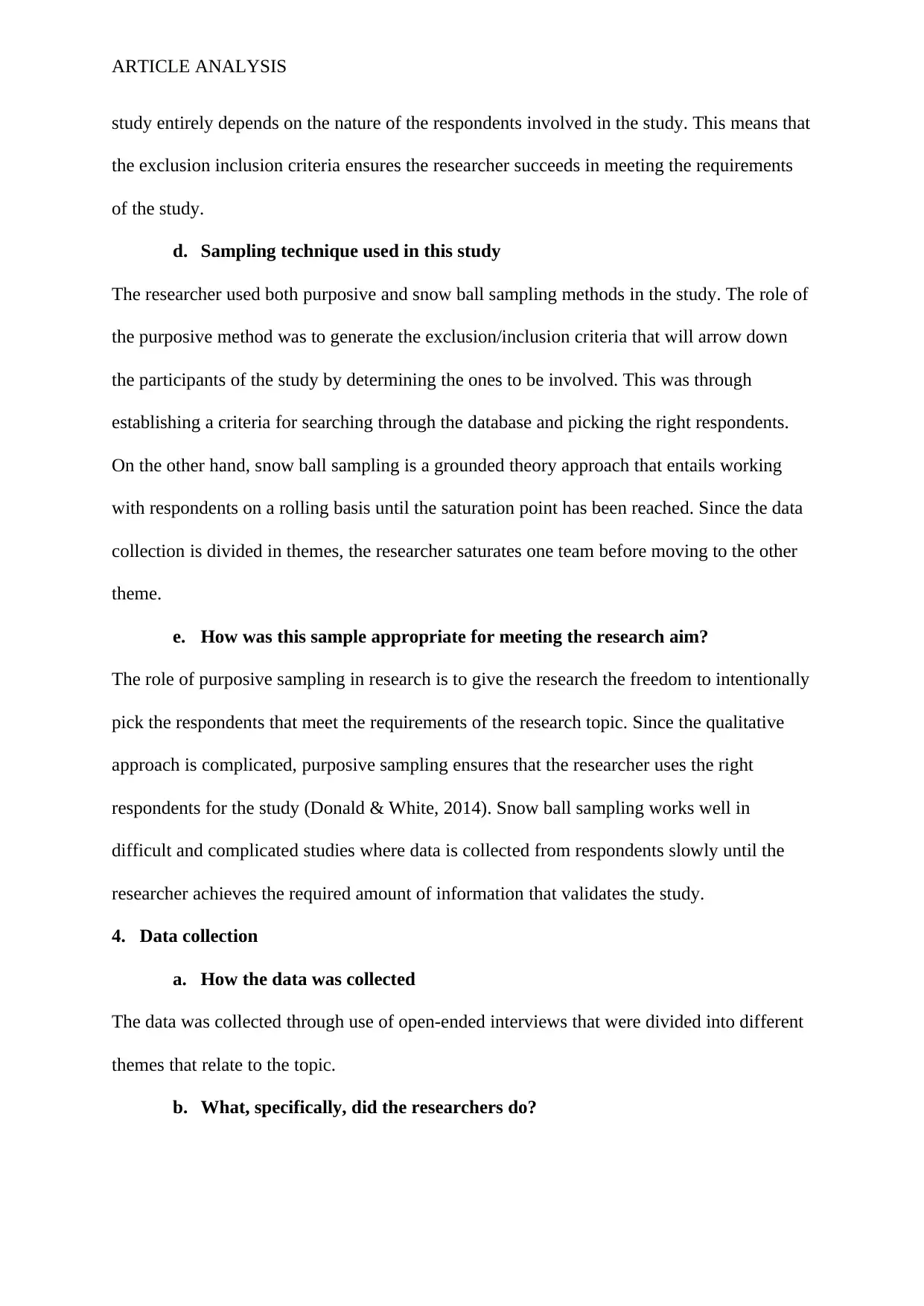
ARTICLE ANALYSIS
study entirely depends on the nature of the respondents involved in the study. This means that
the exclusion inclusion criteria ensures the researcher succeeds in meeting the requirements
of the study.
d. Sampling technique used in this study
The researcher used both purposive and snow ball sampling methods in the study. The role of
the purposive method was to generate the exclusion/inclusion criteria that will arrow down
the participants of the study by determining the ones to be involved. This was through
establishing a criteria for searching through the database and picking the right respondents.
On the other hand, snow ball sampling is a grounded theory approach that entails working
with respondents on a rolling basis until the saturation point has been reached. Since the data
collection is divided in themes, the researcher saturates one team before moving to the other
theme.
e. How was this sample appropriate for meeting the research aim?
The role of purposive sampling in research is to give the research the freedom to intentionally
pick the respondents that meet the requirements of the research topic. Since the qualitative
approach is complicated, purposive sampling ensures that the researcher uses the right
respondents for the study (Donald & White, 2014). Snow ball sampling works well in
difficult and complicated studies where data is collected from respondents slowly until the
researcher achieves the required amount of information that validates the study.
4. Data collection
a. How the data was collected
The data was collected through use of open-ended interviews that were divided into different
themes that relate to the topic.
b. What, specifically, did the researchers do?
study entirely depends on the nature of the respondents involved in the study. This means that
the exclusion inclusion criteria ensures the researcher succeeds in meeting the requirements
of the study.
d. Sampling technique used in this study
The researcher used both purposive and snow ball sampling methods in the study. The role of
the purposive method was to generate the exclusion/inclusion criteria that will arrow down
the participants of the study by determining the ones to be involved. This was through
establishing a criteria for searching through the database and picking the right respondents.
On the other hand, snow ball sampling is a grounded theory approach that entails working
with respondents on a rolling basis until the saturation point has been reached. Since the data
collection is divided in themes, the researcher saturates one team before moving to the other
theme.
e. How was this sample appropriate for meeting the research aim?
The role of purposive sampling in research is to give the research the freedom to intentionally
pick the respondents that meet the requirements of the research topic. Since the qualitative
approach is complicated, purposive sampling ensures that the researcher uses the right
respondents for the study (Donald & White, 2014). Snow ball sampling works well in
difficult and complicated studies where data is collected from respondents slowly until the
researcher achieves the required amount of information that validates the study.
4. Data collection
a. How the data was collected
The data was collected through use of open-ended interviews that were divided into different
themes that relate to the topic.
b. What, specifically, did the researchers do?
Paraphrase This Document
Need a fresh take? Get an instant paraphrase of this document with our AI Paraphraser
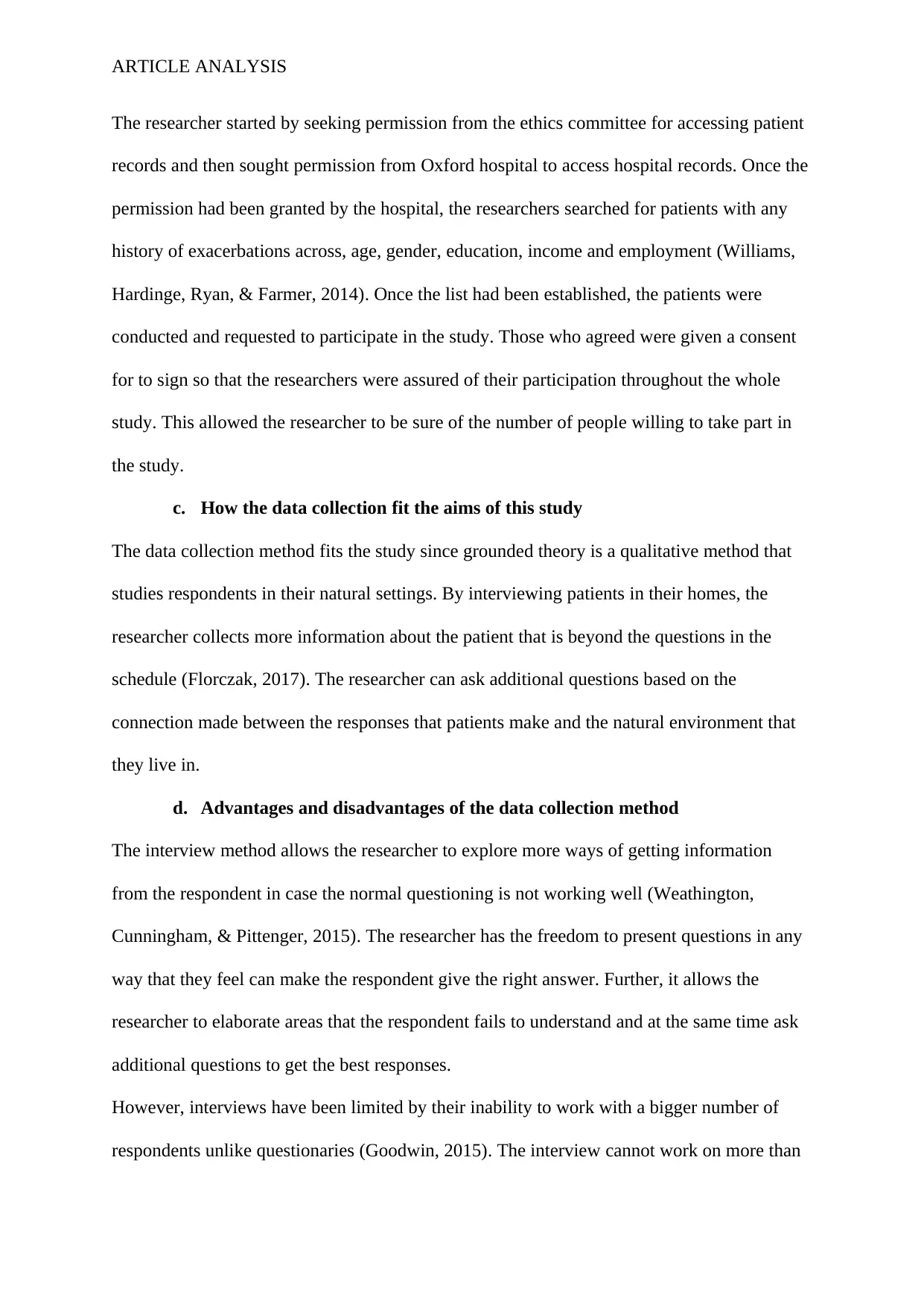
ARTICLE ANALYSIS
The researcher started by seeking permission from the ethics committee for accessing patient
records and then sought permission from Oxford hospital to access hospital records. Once the
permission had been granted by the hospital, the researchers searched for patients with any
history of exacerbations across, age, gender, education, income and employment (Williams,
Hardinge, Ryan, & Farmer, 2014). Once the list had been established, the patients were
conducted and requested to participate in the study. Those who agreed were given a consent
for to sign so that the researchers were assured of their participation throughout the whole
study. This allowed the researcher to be sure of the number of people willing to take part in
the study.
c. How the data collection fit the aims of this study
The data collection method fits the study since grounded theory is a qualitative method that
studies respondents in their natural settings. By interviewing patients in their homes, the
researcher collects more information about the patient that is beyond the questions in the
schedule (Florczak, 2017). The researcher can ask additional questions based on the
connection made between the responses that patients make and the natural environment that
they live in.
d. Advantages and disadvantages of the data collection method
The interview method allows the researcher to explore more ways of getting information
from the respondent in case the normal questioning is not working well (Weathington,
Cunningham, & Pittenger, 2015). The researcher has the freedom to present questions in any
way that they feel can make the respondent give the right answer. Further, it allows the
researcher to elaborate areas that the respondent fails to understand and at the same time ask
additional questions to get the best responses.
However, interviews have been limited by their inability to work with a bigger number of
respondents unlike questionaries (Goodwin, 2015). The interview cannot work on more than
The researcher started by seeking permission from the ethics committee for accessing patient
records and then sought permission from Oxford hospital to access hospital records. Once the
permission had been granted by the hospital, the researchers searched for patients with any
history of exacerbations across, age, gender, education, income and employment (Williams,
Hardinge, Ryan, & Farmer, 2014). Once the list had been established, the patients were
conducted and requested to participate in the study. Those who agreed were given a consent
for to sign so that the researchers were assured of their participation throughout the whole
study. This allowed the researcher to be sure of the number of people willing to take part in
the study.
c. How the data collection fit the aims of this study
The data collection method fits the study since grounded theory is a qualitative method that
studies respondents in their natural settings. By interviewing patients in their homes, the
researcher collects more information about the patient that is beyond the questions in the
schedule (Florczak, 2017). The researcher can ask additional questions based on the
connection made between the responses that patients make and the natural environment that
they live in.
d. Advantages and disadvantages of the data collection method
The interview method allows the researcher to explore more ways of getting information
from the respondent in case the normal questioning is not working well (Weathington,
Cunningham, & Pittenger, 2015). The researcher has the freedom to present questions in any
way that they feel can make the respondent give the right answer. Further, it allows the
researcher to elaborate areas that the respondent fails to understand and at the same time ask
additional questions to get the best responses.
However, interviews have been limited by their inability to work with a bigger number of
respondents unlike questionaries (Goodwin, 2015). The interview cannot work on more than
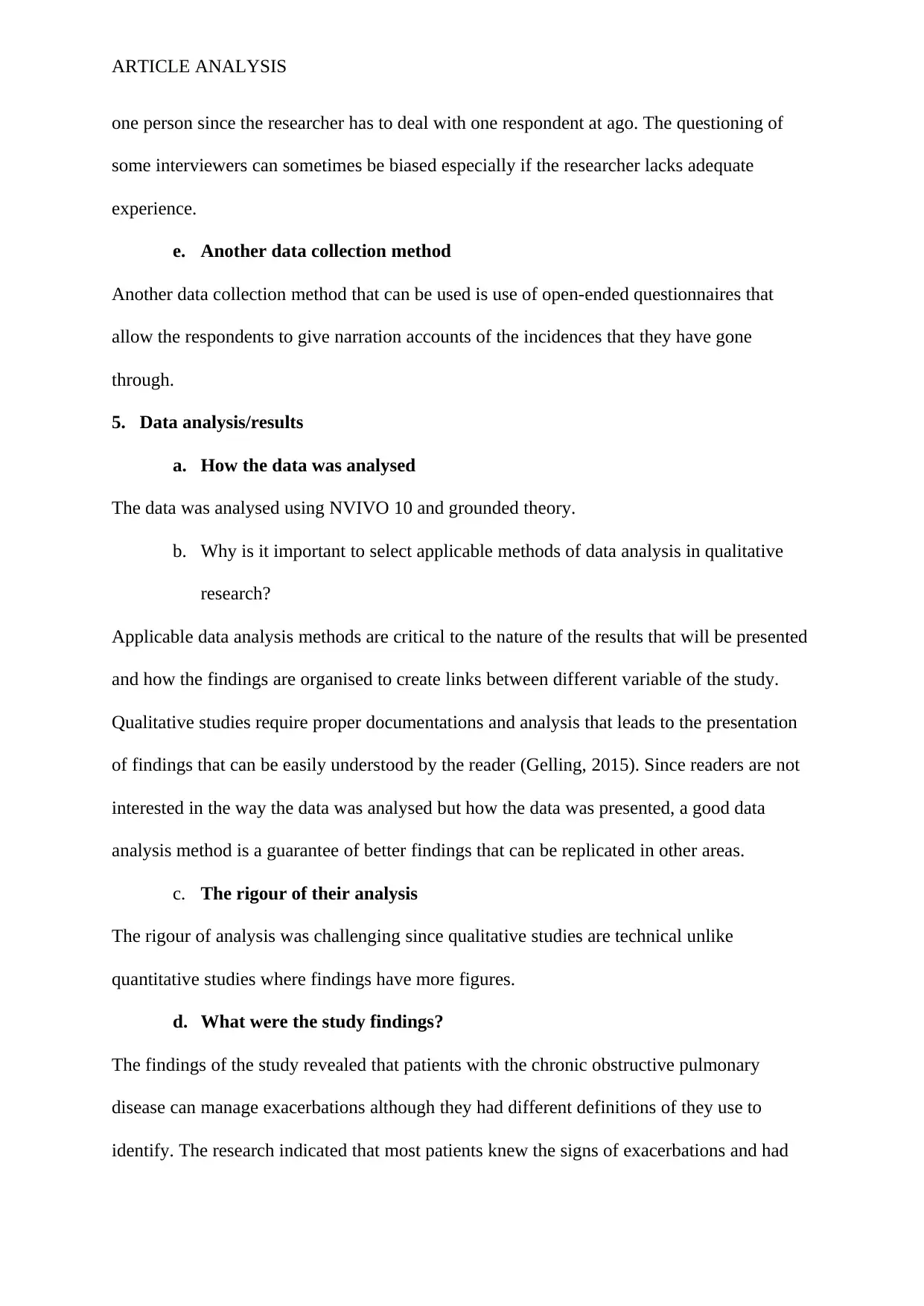
ARTICLE ANALYSIS
one person since the researcher has to deal with one respondent at ago. The questioning of
some interviewers can sometimes be biased especially if the researcher lacks adequate
experience.
e. Another data collection method
Another data collection method that can be used is use of open-ended questionnaires that
allow the respondents to give narration accounts of the incidences that they have gone
through.
5. Data analysis/results
a. How the data was analysed
The data was analysed using NVIVO 10 and grounded theory.
b. Why is it important to select applicable methods of data analysis in qualitative
research?
Applicable data analysis methods are critical to the nature of the results that will be presented
and how the findings are organised to create links between different variable of the study.
Qualitative studies require proper documentations and analysis that leads to the presentation
of findings that can be easily understood by the reader (Gelling, 2015). Since readers are not
interested in the way the data was analysed but how the data was presented, a good data
analysis method is a guarantee of better findings that can be replicated in other areas.
c. The rigour of their analysis
The rigour of analysis was challenging since qualitative studies are technical unlike
quantitative studies where findings have more figures.
d. What were the study findings?
The findings of the study revealed that patients with the chronic obstructive pulmonary
disease can manage exacerbations although they had different definitions of they use to
identify. The research indicated that most patients knew the signs of exacerbations and had
one person since the researcher has to deal with one respondent at ago. The questioning of
some interviewers can sometimes be biased especially if the researcher lacks adequate
experience.
e. Another data collection method
Another data collection method that can be used is use of open-ended questionnaires that
allow the respondents to give narration accounts of the incidences that they have gone
through.
5. Data analysis/results
a. How the data was analysed
The data was analysed using NVIVO 10 and grounded theory.
b. Why is it important to select applicable methods of data analysis in qualitative
research?
Applicable data analysis methods are critical to the nature of the results that will be presented
and how the findings are organised to create links between different variable of the study.
Qualitative studies require proper documentations and analysis that leads to the presentation
of findings that can be easily understood by the reader (Gelling, 2015). Since readers are not
interested in the way the data was analysed but how the data was presented, a good data
analysis method is a guarantee of better findings that can be replicated in other areas.
c. The rigour of their analysis
The rigour of analysis was challenging since qualitative studies are technical unlike
quantitative studies where findings have more figures.
d. What were the study findings?
The findings of the study revealed that patients with the chronic obstructive pulmonary
disease can manage exacerbations although they had different definitions of they use to
identify. The research indicated that most patients knew the signs of exacerbations and had
⊘ This is a preview!⊘
Do you want full access?
Subscribe today to unlock all pages.

Trusted by 1+ million students worldwide
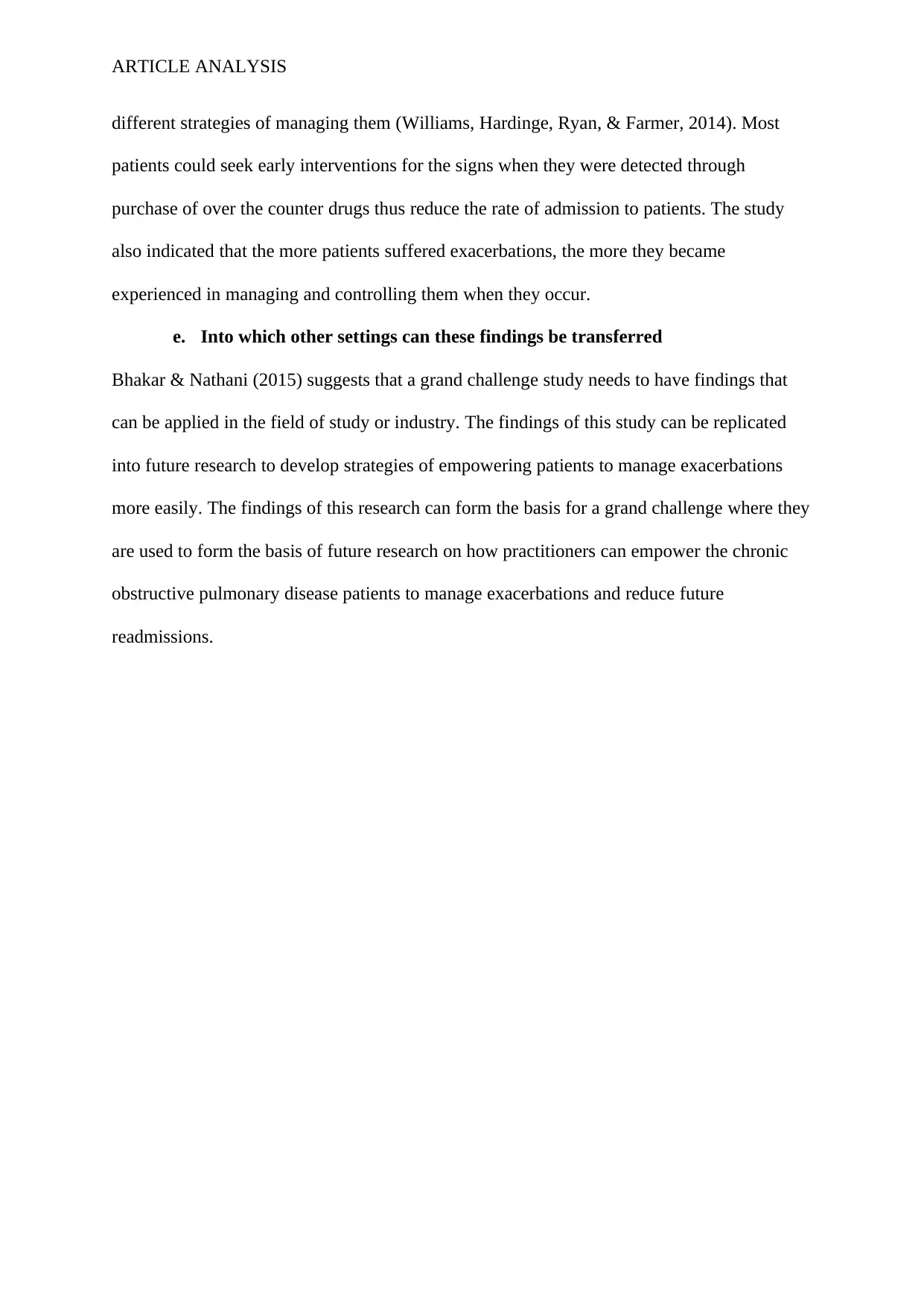
ARTICLE ANALYSIS
different strategies of managing them (Williams, Hardinge, Ryan, & Farmer, 2014). Most
patients could seek early interventions for the signs when they were detected through
purchase of over the counter drugs thus reduce the rate of admission to patients. The study
also indicated that the more patients suffered exacerbations, the more they became
experienced in managing and controlling them when they occur.
e. Into which other settings can these findings be transferred
Bhakar & Nathani (2015) suggests that a grand challenge study needs to have findings that
can be applied in the field of study or industry. The findings of this study can be replicated
into future research to develop strategies of empowering patients to manage exacerbations
more easily. The findings of this research can form the basis for a grand challenge where they
are used to form the basis of future research on how practitioners can empower the chronic
obstructive pulmonary disease patients to manage exacerbations and reduce future
readmissions.
different strategies of managing them (Williams, Hardinge, Ryan, & Farmer, 2014). Most
patients could seek early interventions for the signs when they were detected through
purchase of over the counter drugs thus reduce the rate of admission to patients. The study
also indicated that the more patients suffered exacerbations, the more they became
experienced in managing and controlling them when they occur.
e. Into which other settings can these findings be transferred
Bhakar & Nathani (2015) suggests that a grand challenge study needs to have findings that
can be applied in the field of study or industry. The findings of this study can be replicated
into future research to develop strategies of empowering patients to manage exacerbations
more easily. The findings of this research can form the basis for a grand challenge where they
are used to form the basis of future research on how practitioners can empower the chronic
obstructive pulmonary disease patients to manage exacerbations and reduce future
readmissions.
Paraphrase This Document
Need a fresh take? Get an instant paraphrase of this document with our AI Paraphraser
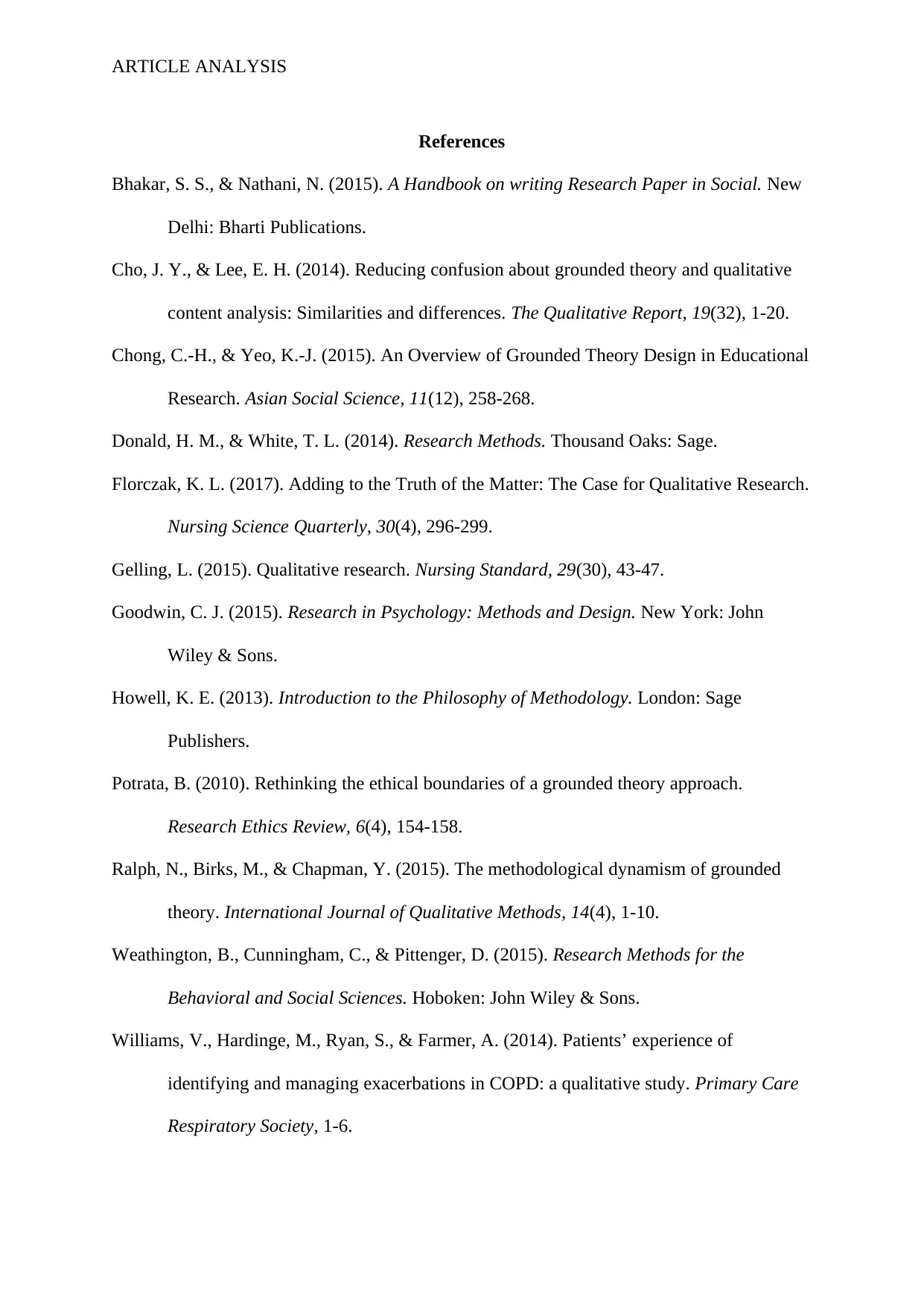
ARTICLE ANALYSIS
References
Bhakar, S. S., & Nathani, N. (2015). A Handbook on writing Research Paper in Social. New
Delhi: Bharti Publications.
Cho, J. Y., & Lee, E. H. (2014). Reducing confusion about grounded theory and qualitative
content analysis: Similarities and differences. The Qualitative Report, 19(32), 1-20.
Chong, C.-H., & Yeo, K.-J. (2015). An Overview of Grounded Theory Design in Educational
Research. Asian Social Science, 11(12), 258-268.
Donald, H. M., & White, T. L. (2014). Research Methods. Thousand Oaks: Sage.
Florczak, K. L. (2017). Adding to the Truth of the Matter: The Case for Qualitative Research.
Nursing Science Quarterly, 30(4), 296-299.
Gelling, L. (2015). Qualitative research. Nursing Standard, 29(30), 43-47.
Goodwin, C. J. (2015). Research in Psychology: Methods and Design. New York: John
Wiley & Sons.
Howell, K. E. (2013). Introduction to the Philosophy of Methodology. London: Sage
Publishers.
Potrata, B. (2010). Rethinking the ethical boundaries of a grounded theory approach.
Research Ethics Review, 6(4), 154-158.
Ralph, N., Birks, M., & Chapman, Y. (2015). The methodological dynamism of grounded
theory. International Journal of Qualitative Methods, 14(4), 1-10.
Weathington, B., Cunningham, C., & Pittenger, D. (2015). Research Methods for the
Behavioral and Social Sciences. Hoboken: John Wiley & Sons.
Williams, V., Hardinge, M., Ryan, S., & Farmer, A. (2014). Patients’ experience of
identifying and managing exacerbations in COPD: a qualitative study. Primary Care
Respiratory Society, 1-6.
References
Bhakar, S. S., & Nathani, N. (2015). A Handbook on writing Research Paper in Social. New
Delhi: Bharti Publications.
Cho, J. Y., & Lee, E. H. (2014). Reducing confusion about grounded theory and qualitative
content analysis: Similarities and differences. The Qualitative Report, 19(32), 1-20.
Chong, C.-H., & Yeo, K.-J. (2015). An Overview of Grounded Theory Design in Educational
Research. Asian Social Science, 11(12), 258-268.
Donald, H. M., & White, T. L. (2014). Research Methods. Thousand Oaks: Sage.
Florczak, K. L. (2017). Adding to the Truth of the Matter: The Case for Qualitative Research.
Nursing Science Quarterly, 30(4), 296-299.
Gelling, L. (2015). Qualitative research. Nursing Standard, 29(30), 43-47.
Goodwin, C. J. (2015). Research in Psychology: Methods and Design. New York: John
Wiley & Sons.
Howell, K. E. (2013). Introduction to the Philosophy of Methodology. London: Sage
Publishers.
Potrata, B. (2010). Rethinking the ethical boundaries of a grounded theory approach.
Research Ethics Review, 6(4), 154-158.
Ralph, N., Birks, M., & Chapman, Y. (2015). The methodological dynamism of grounded
theory. International Journal of Qualitative Methods, 14(4), 1-10.
Weathington, B., Cunningham, C., & Pittenger, D. (2015). Research Methods for the
Behavioral and Social Sciences. Hoboken: John Wiley & Sons.
Williams, V., Hardinge, M., Ryan, S., & Farmer, A. (2014). Patients’ experience of
identifying and managing exacerbations in COPD: a qualitative study. Primary Care
Respiratory Society, 1-6.

ARTICLE ANALYSIS
⊘ This is a preview!⊘
Do you want full access?
Subscribe today to unlock all pages.

Trusted by 1+ million students worldwide
1 out of 9
Related Documents
Your All-in-One AI-Powered Toolkit for Academic Success.
+13062052269
info@desklib.com
Available 24*7 on WhatsApp / Email
![[object Object]](/_next/static/media/star-bottom.7253800d.svg)
Unlock your academic potential
Copyright © 2020–2025 A2Z Services. All Rights Reserved. Developed and managed by ZUCOL.




